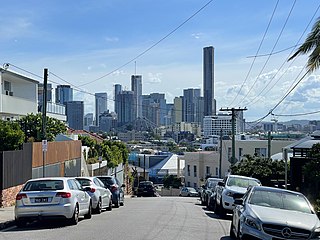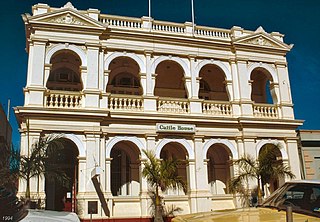
Morningside is a suburb in the City of Brisbane, Queensland, Australia. In the 2016 census, Morningside had a population of 10,481.

Newstead is an inner northern riverside suburb of Brisbane, Queensland, Australia. At the 2016 census, it had a population of 2,193.

Bretts Wharf is a ferry terminal on the northern bank of the Brisbane River in the suburb of Hamilton in the City of Brisbane, Queensland, Australia. It serves patrons from nearby Racecourse Road and Portside Wharf, as well as visitors to Eagle Farm Racecourse and Doomben Racecourse in the Brisbane suburbs of Hamilton and Ascot. Bretts Wharf was the terminus for downstream CityCat services until Apollo Road reopened in February 2008. It is served by RiverCity Ferries' CityCat services.

Bulimba ferry wharf is a heritage-listed ferry wharf at Oxford Street, Bulimba, City of Brisbane, Queensland, Australia. It is located on the southern side of the Brisbane River serving the Brisbane suburb of Bulimba. It is served by RiverCity Ferries' CityCat service and the Cross River service to Teneriffe. It was designed by GHM Addison and Son and built in 1922 by E Taylor. It is also known as Bulimba ferry house and Bulimba waiting shed & landing. It was added to the Queensland Heritage Register on 12 January 2003.

Teneriffe ferry wharf is located on the northern side of the Brisbane River serving the Brisbane suburb of Teneriffe in Queensland, Australia. It is served by RiverCity Ferries' CityCat service and a Cross River service to Bulimba.

Holman Street ferry wharf is a heritage-listed ferry wharf located on the southern side of the Brisbane River in Kangaroo Point, City of Brisbane, Queensland, Australia. It is served by RiverCity Ferries' CityHopper and the Cross River service to Riverside wharf. It was added to the Queensland Heritage Register in 2004.

Regatta ferry wharf is located on the northern side of the Brisbane River serving the Brisbane suburb of Toowong in Queensland, Australia. It is served by RiverCity Ferries' CityCat services.

Transdev Brisbane Ferries, formerly Metrolink Queensland and TransdevTSL Brisbane Ferries, was the operator of the CityCat, CityHopper, and Cross River ferry networks on the Brisbane River in Brisbane, Queensland, Australia from November 2003 until November 2020. The network, operated under contract to the Brisbane City Council, formed part of the TransLink integrated public transport scheme.

Teneriffe is an inner suburb of Brisbane, Australia, 2.5 kilometres (1.6 mi) north-east of the CBD. lt borders Fortitude Valley to the west, Newstead to the north and New Farm to the south.

Bulimba is a suburb in the City of Brisbane, Queensland, Australia. In the 2016 census Bulimba had a population of 6,843 people.

Hawthorne is suburb of the City of Brisbane, Queensland, Australia. In the 2016 census, Hawthorne had a population of 4,989 people.

Apollo Road wharf is a ferry wharf located on the southern side of the Brisbane River serving the Brisbane suburb of Bulimba in Queensland, Australia. It is served by RiverCity Ferries' CityCat services.

Howard Smith Wharves is a heritage-listed wharf on the Brisbane River at Boundary Street, Brisbane City and Fortitude Valley, City of Brisbane, Queensland, Australia. It was built from c. 1934 to 1940s circa. It is also known as Brisbane Central Wharves. The 3.5-hectare (8.6-acre) site is one of the most culturally and historically significant riverfront locations in Brisbane. It was added to the Queensland Heritage Register on 4 February 1997.

St John the Baptist Anglican Church is a heritage-listed church at 171 Oxford Street, Bulimba, Brisbane, Queensland, Australia. It was designed by John Hingeston Buckeridge and built in 1888 by T Whitty. It was added to the Queensland Heritage Register on 9 July 2003.

Bulimba Memorial Park is a heritage-listed park at 129 Oxford Street, Bulimba, Queensland, Australia. It was built from 1919 to 1980s. It is also known as Bulimba Soldiers & Sailors Memorial Park and Jamieson Park. It was added to the Queensland Heritage Register on 21 October 1992.

Bulimba House is a heritage-listed detached house at 34 Kenbury Street, Bulimba, Queensland, Australia. It was designed and built by Andrew Petrie from 1849 to 1850. It is also known as Toogoolawah. It was added to the Queensland Heritage Register on 21 October 1992. A number of timber cottages were constructed around the main house.

Bulimba Reach is a reach of the Brisbane River in Brisbane, Queensland, Australia.

Cattle House is a heritage-listed former bank building at 180 Quay Street, Rockhampton, Rockhampton Region, Queensland, Australia. It was designed by Addison & Corrie and built from 1903 to 1904. It is also known as Union Bank of Australia and the Cattleman's Union building. It was added to the Queensland Heritage Register on 21 October 1992.

RiverCity Ferries is a public transport company which commenced operating ferry services in Brisbane on 4 November 2020. It is a subsidiary of the SeaLink Travel Group.























